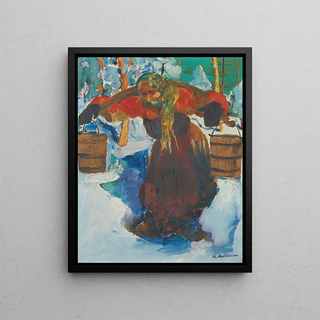Art print | Russian Baba carrying water - Filipp Malyavin


View from behind

Frame (optional)
Art print Baba russe portant de l'eau - Filipp Malyavin – Captivating Introduction
In the vibrant world of Russian art, the work "Baba russe portant de l'eau" by Filipp Malyavin stands out for its evocative power and authenticity. This painting, which captures the very essence of peasant life, immerses us in a world where nature and humanity intertwine with striking delicacy. Through the depiction of a woman carrying a water jug, Malyavin invites us to explore not only the beauty of Russian landscapes but also the depth of the human soul. This piece, both simple and complex, resonates as a tribute to everyday life, while also serving as an open window into a rich and vibrant culture.
Style and uniqueness of the work
Malyavin's style is characterized by bold use of colors and mastery of textures that make every detail palpable. In "Baba russe portant de l'eau," the warm earth tones and vibrant shades of traditional clothing create an atmosphere that is both intimate and universal. The artist succeeds in capturing light in a way that transcends mere realism, offering an almost poetic vision of his subject. The facial features of the protagonist, imbued with wisdom and strength, evoke a personal story, a life of labor and devotion. The composition, centered on the female figure, immediately draws the eye and invites contemplation, making this work a true masterpiece of Russian painting.
The artist and his influence
Filipp Malyavin, born in 1869, is an emblematic figure of early 20th-century Russian art. Raised in a rural environment, he was always deeply influenced by peasant culture and folk traditions of his country. His work fits into a broader movement that seeks to rediscover and celebrate the roots of Russian identity. Malyavin managed to combine realism with a more expressive approach, creating a unique visual language that is his own. His influence is felt not only in his works but also in how he inspired many contemporary artists to explore themes of everyday life and popular culture. Through his paintings

Matte finish

View from behind

Frame (optional)
Art print Baba russe portant de l'eau - Filipp Malyavin – Captivating Introduction
In the vibrant world of Russian art, the work "Baba russe portant de l'eau" by Filipp Malyavin stands out for its evocative power and authenticity. This painting, which captures the very essence of peasant life, immerses us in a world where nature and humanity intertwine with striking delicacy. Through the depiction of a woman carrying a water jug, Malyavin invites us to explore not only the beauty of Russian landscapes but also the depth of the human soul. This piece, both simple and complex, resonates as a tribute to everyday life, while also serving as an open window into a rich and vibrant culture.
Style and uniqueness of the work
Malyavin's style is characterized by bold use of colors and mastery of textures that make every detail palpable. In "Baba russe portant de l'eau," the warm earth tones and vibrant shades of traditional clothing create an atmosphere that is both intimate and universal. The artist succeeds in capturing light in a way that transcends mere realism, offering an almost poetic vision of his subject. The facial features of the protagonist, imbued with wisdom and strength, evoke a personal story, a life of labor and devotion. The composition, centered on the female figure, immediately draws the eye and invites contemplation, making this work a true masterpiece of Russian painting.
The artist and his influence
Filipp Malyavin, born in 1869, is an emblematic figure of early 20th-century Russian art. Raised in a rural environment, he was always deeply influenced by peasant culture and folk traditions of his country. His work fits into a broader movement that seeks to rediscover and celebrate the roots of Russian identity. Malyavin managed to combine realism with a more expressive approach, creating a unique visual language that is his own. His influence is felt not only in his works but also in how he inspired many contemporary artists to explore themes of everyday life and popular culture. Through his paintings






